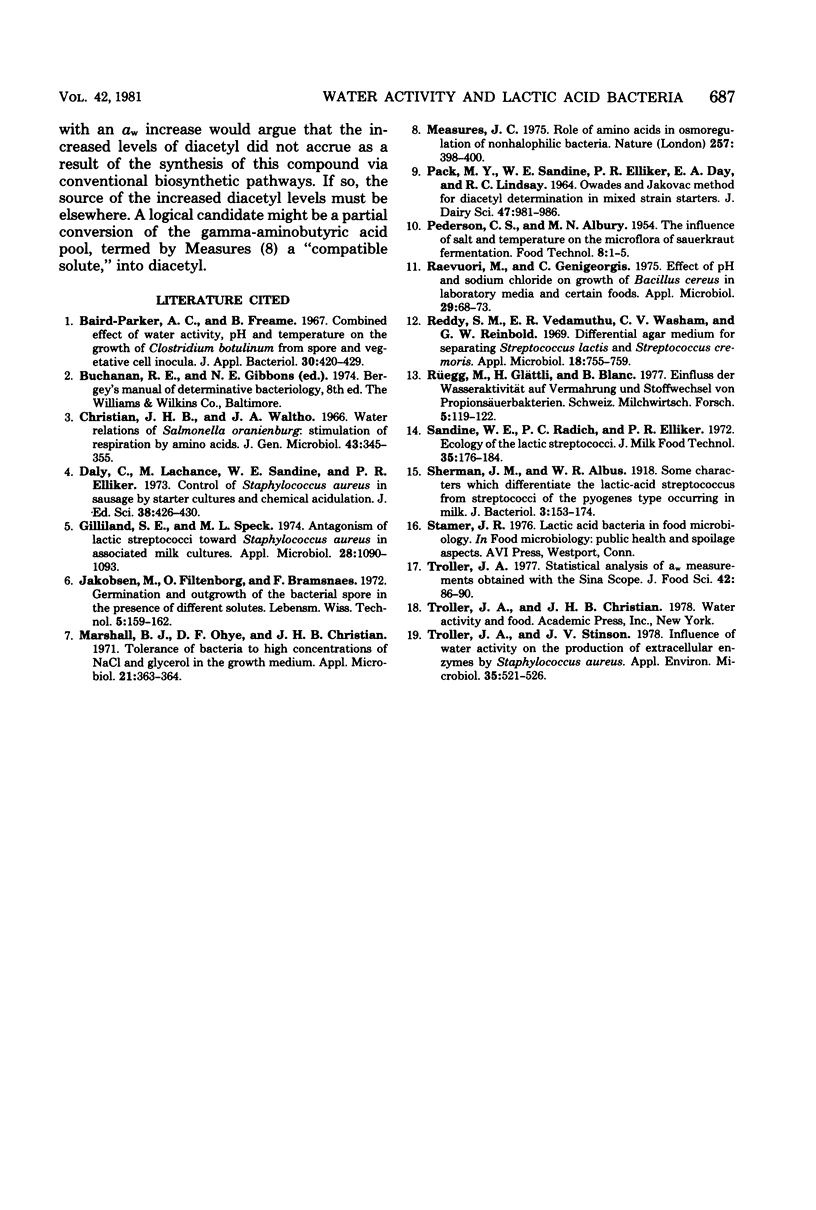Abstract
The effect of water activity (aw) reduction on growth and acid and diacetyl production by three lactic streptococci was studied. In addition, the influence of low moisture conditions on several bacteria of significance in the fermentation of sauerkraut was examined. The minimal aw supporting growth of dairy lactics was 0.93 in a medium adjusted with glycerol. Media adjusted with sucrose generally were more inhibitory than those in which glycerol was the humectant. Titratable acidity, although not related to the type of humectant, did depend on the aw of the medium and was directly related to the extent of growth. Diacetyl concentration increased in cultures of reduced aw when the media were adjusted with both humectants; however, the effect was greatest with glycerol. A lactic strain associated with sauerkraut fermentation appeared to grow at a lower minimal aw in a glycerol-adjusted medium than in a system adjusted with NaCl; however, none of the sauerkraut organisms grew at aw levels of <0.95 when NaCl was the solute. Acid production appeared to be related to the presence and extent of growth at all of the aw levels studied.
Full text
PDF





Selected References
These references are in PubMed. This may not be the complete list of references from this article.
- Baird-Parker A. C., Freame B. Combined effect of water activity, pH and temperature on the growth of Clostridium botulinum from spore and vegetative cell inocula. J Appl Bacteriol. 1967 Dec;30(3):420–429. doi: 10.1111/j.1365-2672.1967.tb00320.x. [DOI] [PubMed] [Google Scholar]
- Christian J. H., Waltho J. A. Water relations of Salmonella oranienburg; stimulation of respiration by amino acids. J Gen Microbiol. 1966 Jun;43(3):345–355. doi: 10.1099/00221287-43-3-345. [DOI] [PubMed] [Google Scholar]
- Gilliland S. E., Speck M. L. Antagonism of lactic streptococci toward Staphylococcus aureus in associative milk cutures. Appl Microbiol. 1974 Dec;28(6):1090–1093. doi: 10.1128/am.28.6.1090-1093.1974. [DOI] [PMC free article] [PubMed] [Google Scholar]
- Marshall B. J., Ohye D. F., Christian J. H. Tolerance of bacteria to high concentrations of NaCl and glycerol in the growth medium. Appl Microbiol. 1971 Feb;21(2):363–364. doi: 10.1128/am.21.2.363-364.1971. [DOI] [PMC free article] [PubMed] [Google Scholar]
- Measures J. C. Role of amino acids in osmoregulation of non-halophilic bacteria. Nature. 1975 Oct 2;257(5525):398–400. doi: 10.1038/257398a0. [DOI] [PubMed] [Google Scholar]
- Raevuori M., Genigeorgis C. Effect of pH and sodium chloride on growth of Bacillus cereus in laboratory media and certain foods. Appl Microbiol. 1975 Jan;29(1):68–73. doi: 10.1128/am.29.1.68-73.1975. [DOI] [PMC free article] [PubMed] [Google Scholar]
- Reddy M. S., Vedamuthu E. R., Washam C. J., Reinbold G. W. Differential agar medium for separating Streptococcus lactis and Streptococcus cremoris. Appl Microbiol. 1969 Nov;18(5):755–759. doi: 10.1128/am.18.5.755-759.1969. [DOI] [PMC free article] [PubMed] [Google Scholar]
- Sherman J. M., Albus W. R. Some Characters which Differentiate the Lactic-acid Streptococcus from Streptococci of the Pyogenes Type Occurring in Milk. J Bacteriol. 1918 Mar;3(2):153–174. doi: 10.1128/jb.3.2.153-174.1918. [DOI] [PMC free article] [PubMed] [Google Scholar]
- Troller J. A., Stinson J. V. Influence of water activity on the production of extracellular enzymes by Staphylococcus aureus. Appl Environ Microbiol. 1978 Mar;35(3):521–526. doi: 10.1128/aem.35.3.521-526.1978. [DOI] [PMC free article] [PubMed] [Google Scholar]


